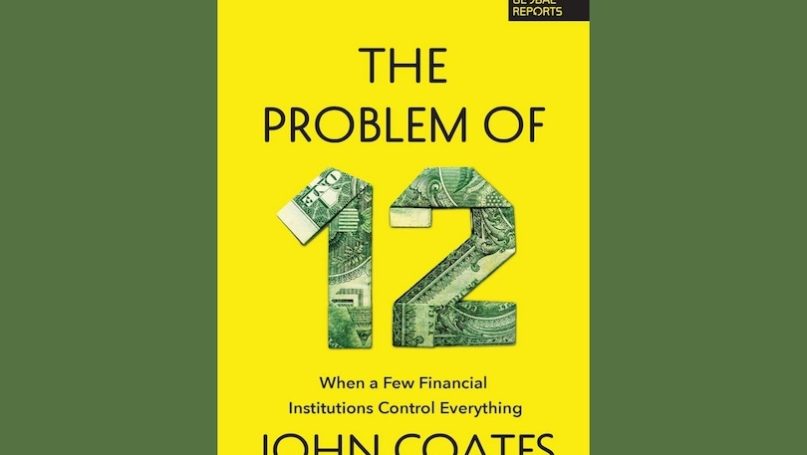
The Problem of Twelve: When a Few Financial Institutions Control Everything
By John Coates
Columbia Global Reports, 2023
Industry concentration in modern economies has long been the focus of academics and policymakers, eventually motivating vigorous conceptual and public policy debates on structure, conduct and performance, and the market-driven system as a whole. Over the years, the evidence shows it’s good to have the market on your side across the whole spectrum of public policy objectives. So it’s equally important to understand market dynamics, and how the market itself is structured in contributing to resource-allocation efficiency and economic growth through available factors of production, factor productivity and technological change. And what externalities, positive and negative, are generated along the way?
In this short volume, John Coates, a faculty member at the Harvard Law School with a serious track record in advising financial firms as well as public service, casts a skeptical eye on the issue of concentration in the US financial industry based mainly on two specific sectors: index funds and private equity funds. He argues that the degree of concentration that has evolved in each of these sectors, signaled by the title of the book, incorporates blemishes that offset some of the key benefits of US market capitalism. Importantly, this includes a frank discussion of relations between the dominant financial intermediaries and their clients, and among each other.
Mainly unaddressed in this short book is the competitive design of many of the financial firms themselves — notably those presenting themselves as “universal,” able to apply both economies of scale and economies scope across their activities, client targets and geographies, while dealing effectively with the inevitable conflicts of interest and regulatory complexities that arise. When financial concentration is a concern — as the author posits — it matters who is doing the concentrating. So far, the zoo is home to a robust variety of animals ranging from JP Morgan to KKR, which should help allay some of the concerns about where things are headed. Here, it would have been informative to include a Herfindahl-Hirshman analysis of what has happed to market shares within the 12-firm cohort. It could be that despite growing concentration of the collective 12 firms, market shares within the 12 have become more evenly distributed, possible easing some of the concentration concerns.
Most of the anecdotes presented in the book are well known, but they are woven into the fabric of a concentration story that carries credibility for readers who have been around long enough. Defenders of liberal capital markets wonder whether their faith in vigorous competition can be reconciled with growing concentration (and often cooperation) described in the narrative — sometimes close to the edge of acceptable conduct, regulatory constraints and the law — backed by powerful lobbying activity to create, among other things, a federal tax environment not available to anyone else.
Radiating from the industry-hub industrial organization story focused mainly on index funds and private equity — associated with “dark” business conduct away from public markets and information dissemination — are “spokes” that reach into key economic and political issues that encompass US income and wealth distribution.
Some readers will be astounded by the author’s anecdotal evidence of income and wealth ascribed to many of the leaders of the 12 finance players in focus. Americans have been generally tolerant of big income and wealth gaps as largely being the outcome of market forces, with plenty of positive spillovers for the rest of society along the way. Yet his tolerant attitude can change — on issues like wealth taxation for example — and that in turn can threaten the positive functions of the finance sector. When cheats come on the scene, the public expects vigorous prosecution lest the rot undermine the fundamentals of the system and the baby goes out with the bathwater. Of course, the ultra-wealthy die sooner or later, and financial fortunes eventually dissipate. Plus, they give away vast amounts to worthy causes that elsewhere in the world depend entirely on taxpayers — whether they are opera-goers or not.
This is an enjoyable book to read, certainly for those who were around during the systemic changes in the finance and investments sector in the 1980s and 1990s, and they will appreciate the well-integrated vignettes used to make key points or illustrate how the underlying competitive concentration hypothesis has surfaced in the real world. Those too young to have observed these events and trying to gain exposure in the sanitized environment of a classroom (mostly from academics who unlike the author have little first-hand industry experience) can easily grasp the competitive structure core of the argument and learn from the applications — once they have command of the underlying drivers, key market participants and special jargon. For someone as close to the action as the author, it took some spunk to write this book. Some in the industry will, no doubt, be displeased with key arguments, and with some of the supporting evidence. But many of the industry leaders don’t have a lot of time to read anyway, and will leave it to underlings to get excited when systemic flaws are alleged and it comes time to propose reforms that challenge the “problem of twelve.”